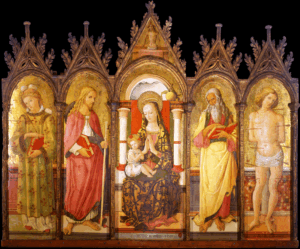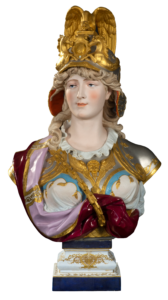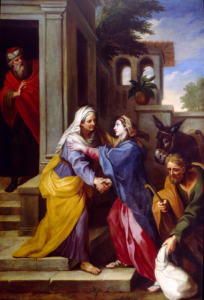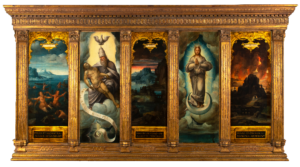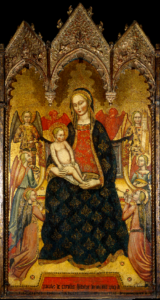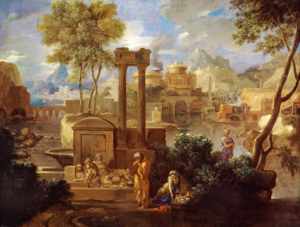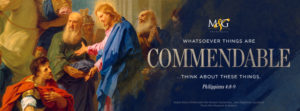In this beautifully tranquil scene, Michel Corneille includes a variety of traditional symbols highlighting Christ’s sacrifice for our sin.
Tag Archives: French
Bust of Athena
Porcelain
Unknown Sculptor, after Paul Duboy
French, 1860-1880
M&G’s magnificent porcelain bust of a female warrior presents the viewer with two fascinating mysteries.
Who Crafted It?
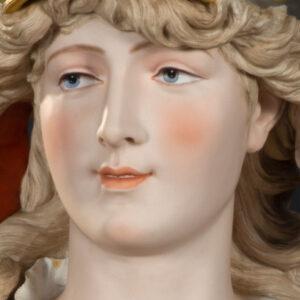 The bust has no signature or manufacture’s marks. The base does, but documented provenance of the piece, which dates to the mid-twentieth century, reveals that the base is not original to the sculpture. Experts have examined M&G’s bust and place its manufacture in France between 1860 and 1880. At that time similar, elaborately dressed busts were popular, and the techniques needed to produce the richly colored glazes for the clothing and accessories while leaving smooth, lightly colored biscuit porcelain for the skin and various details had been perfected. The contrast between the solid, smooth, glossy sections and the soft, matte texture of the biscuit sections heightens the visual interest of works like these.
The bust has no signature or manufacture’s marks. The base does, but documented provenance of the piece, which dates to the mid-twentieth century, reveals that the base is not original to the sculpture. Experts have examined M&G’s bust and place its manufacture in France between 1860 and 1880. At that time similar, elaborately dressed busts were popular, and the techniques needed to produce the richly colored glazes for the clothing and accessories while leaving smooth, lightly colored biscuit porcelain for the skin and various details had been perfected. The contrast between the solid, smooth, glossy sections and the soft, matte texture of the biscuit sections heightens the visual interest of works like these.
Paul Duboy (1830-1887), a French sculptor, exhibited his sculpture at the prestigious Paris Salon from 1853-1882. Duboy made and signed busts similar to M&G’s sculpture, which lacks his elaborate signature on its back. Yet, because of its similarity to his other works, authorities have suggested using “in the manner of” or “after” Paul Duboy.
Who Is This Female Warrior?
From the pantheon of candidates, the personification of the French Republic has been suggested. During the French Revolution, Marianne embodied the qualities valued by French citizens: liberty, equality, fraternity, and reason. M&G’s bust, however, lacks the Phrygian cap, laurel wreath or spiked diadem, and other visual symbols attributed to Marianne.
The Greek goddess Athena is a more likely candidate. Zeus, the chief Greek deity, was her father. Legend tells that Athena sprang full-grown from Zeus’s forehead dressed in complete Greek armor. As the goddess of war, Athena participated in the Trojan War and has generally been portrayed with a spear or bow and arrows. She was also the goddess of domestic handicrafts, animal husbandry, and wisdom. Generally, she used her wisdom to supply warriors with the tactics, strategy, and inspiration needed to defeat enemies. Animal symbols associated with Athena include the owl and snake, both representing wisdom (she also cursed Medusa with hair of snakes), and the horse referencing her teaching man how to tame the animal. While an unusual artistic reference, perhaps the horses on M&G’s helmet symbolize this lore. The eagle-winged dragon atop M&G’s helmet, however, has no known Athenian reference.
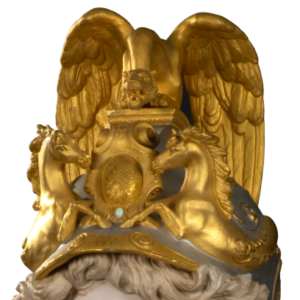 Another possible female warrior may be Minerva, the Roman version of Athena. The two share similar attributes, but the Roman goddess of war is usually depicted wearing an Attic helmet, which does not cover the face but often has ear guards, and may have decorative elements on top. Roman soldiers typically wore Attic helmets and variations were common after the fall of the Roman empire. M&G’s bust wears a greatly-modified and highly-decorated Attic helmet.
Another possible female warrior may be Minerva, the Roman version of Athena. The two share similar attributes, but the Roman goddess of war is usually depicted wearing an Attic helmet, which does not cover the face but often has ear guards, and may have decorative elements on top. Roman soldiers typically wore Attic helmets and variations were common after the fall of the Roman empire. M&G’s bust wears a greatly-modified and highly-decorated Attic helmet.
Virtually all artist renderings of both Athena and Minerva wear loose-fitting Greco-Roman garments, even when they wear armor. M&G’s bust is elaborately dressed and draped in the manner of many busts from the period of its manufacture. She also wears hints of decorative gold armor and a massive, ornate gold chain.
Some of the busts produced in this period are identified as famous individuals and with a name included on the sculpture. Most, however, are simply beautiful works of art with generic titles, not based on any specific individual. M&G’s bust may simply be a beautiful porcelain piece by an unknown, skilled artist depicting a female warrior.
The bust has presented more mysteries than answers. However, if you examine the piece closely you can be assured of two things: you will be impressed with its artistic quality and beauty, and you will gain a better understanding of the phrase “a porcelain complexion.”
Bill Pinkston, retired educator and M&G volunteer
Published 2024
Scenes from the Apocalypse
Oil on panel
Unknown French, mid-16th century
These M&G panels are painted sections from a winged altarpiece, positioned on, above, or behind the church’s altar. The wings or hinged doors would be opened for liturgical feasts and events. When the wings were closed, the side facing the audience was often painted in monochrome colors depicting various saints’ lives; as the wings were opened, the interior (including the other side of the doors) revealed more colorful pictures with a large feature painting in the center.
The Scenes from the Apocalypse by an unknown 16th-century French artist illustrates the medieval tradition of the Signs of the Apocalypse (drawn from Mark 13 and Revelation). These five separate panels were once joined in a single winged altarpiece with a total of fourteen or fifteen panels detailing the Signs and with the central interior panel possibly featuring the Last Judgment. Viewing these works from left to right,
- Panel 1 is the Third Sign: sea monsters that ravage the seas.
- Panel 2 is the reverse of Panel 1, being once united as a single panel.
- Panel 3 is the Second Sign: the seas disappearing into the earth.
- Panel 4 is the reverse of Panel 5, being once united as a single panel.
- Panel 5 is the Fourth Sign: the burning of the seas and rivers.
Two ideas are fundamental to understanding this altarpiece. First, these panels illustrate the Word of God. According to Pope Gregory the Great (lived c.540-604), “Illiterate men can contemplate in the lines of a picture what they cannot learn by means of the written word.” Seeing the horrors of the End Times should motivate the viewer to take action to avoid them. These panels become visual conviction.
The Bible portrays man’s sinfulness and presents the atoning work of Christ as the remedy. The panels’ subject matter confronts the viewer with the penalty for sin even before the Last Judgment arrives. Juxtaposing these panels directly with the altar argues that Christ’s sacrificial death on the cross, accepted by God the Father as payment for man’s sin and ratified by Christ’s resurrection from the dead, is man’s rescue from the Apocalypse. In view of these coming events, the physical placement of these panels prompts the viewer to appropriate for himself Christ’s sacrifice.
Secondly, the reverse of the panels—scenes from the lives of Old and New Testament figures—argues for the ability of humans to react properly to the revelation of God’s Word.
- Panel 2 references the conversion of Saul of Tarsus when confronted with the crucified Christ. The presence of the Holy Spirit as the dove and the holding of the slain Christ by God the Father clearly teaches the unity of the Trinity: Saul’s persecution of followers of Christ is persecution of the God that his pharisaical upbringing revered. The panel directly challenges the viewer to answer the Trinity in the same way Saul did: “What would you have me to do, Lord?”
- Panel 4 is the Woman Clothed with the Sun. She is labeled in the Revelation as a sign (12:1), but not included in the medieval list of signs. The artist portrays the Woman just as the Scripture does: “clothed with the sun, and the moon under her feet, and upon her head a crown of twelve stars.” Though many critics identify this Woman as the Virgin Mary, a continued reading of the biblical text—and a careful examination of the panel—shows that this Woman symbolizes the nation Israel whose annihilation the Dragon seeks in the Last Days. Note the dragon tail just visible at the bottom of the panel. The Jewish child is Christ who escapes the Dragon. But “the woman fled into the wilderness, where she hath a place prepared of God that they should feed her there a thousand two hundred and threescore days” (12:6). Mary is not present at the end of the world, but the nation that brought forth the Messiah is. This panel, too, points to Christ as the provision of salvation from destruction of the Last Days.
Like the Pricke of Conscience, a series of stained-glass windows also based on the Signs of the Last Days, M&G’s panels challenge the viewer to consider the Apocalypse from a personal point of view.
Dr. Karen Rowe Jones, M&G board member
Published 2023
Enjoy this series of segments highlighting Picture Books of the Past: Reading Old Master Paintings, a loan exhibition of 60+ works from the M&G collection. The exhibit has traveled to The Museum of the Bible in Washington, D.C. and the Orlando Museum of Art in Florida.
Gustave Doré was a prolific painter, illustrator, engraver, and sculptor. He published his first drawings at age 15 and went on to become the most sought-after illustrator of the mid-19th century.
